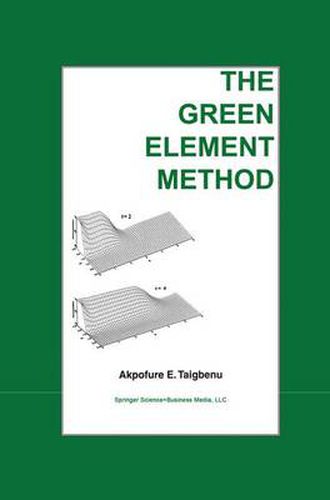Readings Newsletter
Become a Readings Member to make your shopping experience even easier.
Sign in or sign up for free!
You’re not far away from qualifying for FREE standard shipping within Australia
You’ve qualified for FREE standard shipping within Australia
The cart is loading…






This title is printed to order. This book may have been self-published. If so, we cannot guarantee the quality of the content. In the main most books will have gone through the editing process however some may not. We therefore suggest that you be aware of this before ordering this book. If in doubt check either the author or publisher’s details as we are unable to accept any returns unless they are faulty. Please contact us if you have any questions.
The Green element method (GEM) is a novel approach of implementing in an element-by-element fashion the singular boundary integral theory, thereby enhancing the capabilities of the theory in terms of ease in solving nonlinear problems, adapting to heterogeneous problems, and achieving spareness in the global coefficient matrix. By proceeding in this manner, GEM provides solutions to linear, nonlinear, steady and transient engineering problems in one- and two-dimensional domains, some of which hitherto could not be handled by the boundary integral theory. The primary motivation for the Green element method, therefore, lies in the enhancement of the computational capabilities that it has given to the boundary element theory. The main objectives of this text are to serve as an instructional material to senior undergraduate and first-year graduate students undertaking a course in computational methods and their applications to engineering problems, and as a resource material for research scientists, applied mathematicians, numerical analysts, and engineers who may wish to take these ideas to new frontiers and applications. To enhance the feel for the method, exercises are presented at the end of some of the chapters, and sample data can be run with the executable program GEMLN1D that can be accessed either at: www.nust.ac.zw/aetaigbenu/gem/GEMLN1D or: www.lafetech.com/gem/GEMLN1D.
$9.00 standard shipping within Australia
FREE standard shipping within Australia for orders over $100.00
Express & International shipping calculated at checkout
This title is printed to order. This book may have been self-published. If so, we cannot guarantee the quality of the content. In the main most books will have gone through the editing process however some may not. We therefore suggest that you be aware of this before ordering this book. If in doubt check either the author or publisher’s details as we are unable to accept any returns unless they are faulty. Please contact us if you have any questions.
The Green element method (GEM) is a novel approach of implementing in an element-by-element fashion the singular boundary integral theory, thereby enhancing the capabilities of the theory in terms of ease in solving nonlinear problems, adapting to heterogeneous problems, and achieving spareness in the global coefficient matrix. By proceeding in this manner, GEM provides solutions to linear, nonlinear, steady and transient engineering problems in one- and two-dimensional domains, some of which hitherto could not be handled by the boundary integral theory. The primary motivation for the Green element method, therefore, lies in the enhancement of the computational capabilities that it has given to the boundary element theory. The main objectives of this text are to serve as an instructional material to senior undergraduate and first-year graduate students undertaking a course in computational methods and their applications to engineering problems, and as a resource material for research scientists, applied mathematicians, numerical analysts, and engineers who may wish to take these ideas to new frontiers and applications. To enhance the feel for the method, exercises are presented at the end of some of the chapters, and sample data can be run with the executable program GEMLN1D that can be accessed either at: www.nust.ac.zw/aetaigbenu/gem/GEMLN1D or: www.lafetech.com/gem/GEMLN1D.